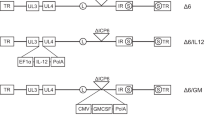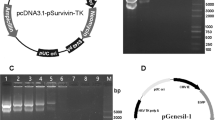Abstract
The therapeutic efficacy of herpes simplex virus thymidine kinase/ganciclovir (HSV-tk/GCV) system in many types of tumors is unsatisfactory due to the insufficient spread of gene transfer and insufficient cell killing. In the current study, we investigated whether adenovirally delivered monocyte chemoattractant protein (MCP)-1 potentiates the antitumor effects of the HSV-tk/GCV system in hepatocellular carcinoma (HCC) cells. Subcutaneous tumor foci of the human HCC cell line, HuH7, established in athymic mice were directly transduced with a recombinant adenovirus (rAd) harboring an HSV-tk gene driven by a human α-fetoprotein promoter, followed by GCV administration. Subsequently, another rAd expressing MCP-1 under the universal CAG promoter was injected. The growth of tumors was markedly suppressed by codelivering HSV-tk and MCP-1 genes compared to that by either HSV-tk/GCV or MCP-1 delivery. In the tumor tissues, monocyte/macrophage infiltration was detected immunohistochemically. The antitumor effects of the rAd expressing MCP-1 were markedly reduced by the administration of carrageenan, a compound known to inactivate macrophage. These results indicate that adenovirally delivered MCP-1 enhanced the antitumor effects of the HSV-tk/GCV system synergistically by recruitment/activation of macrophages in tumor tissues, suggesting an effective immunotherapy for HCC and other lineages of tumors when used adjuvantly with a suicide gene. Cancer Gene Therapy (2001) 8, 695–704
This is a preview of subscription content, access via your institution
Access options
Subscribe to this journal
Receive 12 print issues and online access
$259.00 per year
only $21.58 per issue
Buy this article
- Purchase on Springer Link
- Instant access to full article PDF
Prices may be subject to local taxes which are calculated during checkout
Similar content being viewed by others
References
Venook AP . Treatment of hepatocellular carcinoma: too many options? J Clin Oncol 1994 12: 1323–1334
Trinchet JC, Beaugrand M . Treatment of hepatocellular carcinoma in patients with cirrhosis J Hepatol 1997 27: 756–765
Bruix J . Treatment of hepatocellular carcinoma Hepatology 1997 25: 259–262
Colombo M . Treatment of hepatocellular carcinoma J Viral Hepatol 1997 4: 125–130
Kanai F, Shiratori Y, Yoshida Y, et al . Gene therapy for alpha-fetoprotein–producing human hepatoma cells by adenovirus-mediated transfer of the herpes simplex virus thymidine kinase gene Hepatology 1996 23: 1359–1368
Kanai F, Lan KH, Shiratori Y, et al . In vivo gene therapy for alpha-fetoprotein–producing hepatocellular carcinoma by adenovirus-mediated transfer of cytosine deaminase gene Cancer Res 1997 57: 461–465
Kaneko S, Hallenbeck P, Kotani T, et al . Adenovirus-mediated gene therapy of hepatocellular carcinoma using cancer-specific gene expression Cancer Res 1995 55: 5283–5287
Cao G, Kuriyama S, Du P, et al . Construction of retroviral vectors to induce strong hepatoma cell–specific expression of cytokine genes J Gastroenterol Hepatol 1996 11: 1053–1061
Qin XQ, Tao N, Dergay A, et al . Interferon-beta gene therapy inhibits tumor formation and causes regression of established tumors in immune-deficient mice Proc Natl Acad Sci USA 1998 95: 14411–14416
Fricker J . Hepatocellular carcinoma and p53 gene therapy [news] Mol Med Today 1996 2: 361
Anderson SC, Johnson DE, Harris MP, et al . p53 gene therapy in a rat model of hepatocellular carcinoma: intra-arterial delivery of a recombinant adenovirus Clin Cancer Res 1998 4: 1649–1659
Bookstein R, Demers W, Gregory R, et al . p53 gene therapy in vivo of hepatocellular and liver metastatic colorectal cancer Semin Oncol 1996 23: 66–77
Anderson WF . Human gene therapy Nature 1998 392: 25–30
Culver KW, Ram Z, Wallbridge S, et al . In vivo gene transfer with retroviral vector–producer cells for treatment of experimental brain tumors [see comments] Science 1992 256: 1550–1552
Wu JK, Cano WG, Meylaerts SA, et al . Bystander tumoricidal effect in the treatment of experimental brain tumors Neurosurgery 1994 35: 1094–1102 discussion 1102–1093
Elshami AA, Saavedra A, Zhang H, et al . Gap junctions play a role in the “bystander effect” of the herpes simplex virus thymidine kinase/ganciclovir system in vitro Gene Ther 1996 3: 85–92
Ramesh R, Marrogi AJ, Munshi A, Abboud CN, Freeman SM . In vivo analysis of the “bystander effect”: a cytokine cascade Exp Hematol 1996 24: 829–838
Freeman SM, Ramesh R, Shastri M, et al . The role of cytokines in mediating the bystander effect using HSV-TK xenogeneic cells Cancer Lett 1995 92: 167–174
Santodonato L, Ferrantini M, Gabriele L, et al . Cure of mice with established metastatic friend leukemia cell tumors by a combined therapy with tumor cells expressing both interferon-alpha 1 and herpes simplex thymidine kinase followed by ganciclovir Hum Gene Ther 1996 7: 1–10
Moriuchi S, Oligino T, Krisky D, et al . Enhanced tumor cell killing in the presence of ganciclovir by herpes simplex virus type 1 vector-directed coexpression of human tumor necrosis factor-alpha and herpes simplex virus thymidine kinase Cancer Res 1998 58: 5731–5737
Matsushima K, Larsen CG, DuBois GC, Oppenheim JJ . Purification and characterization of a novel monocyte chemotactic and activating factor produced by a human myelomonocytic cell line J Exp Med 1989 169: 1485–1490
Rollins BJ, Sunday ME . Suppression of tumor formation in vivo by expression of the JE gene in malignant cells Mol Cell Biol 1991 11: 3125–3131
Hirose K, Hakozaki M, Nyunoya Y, et al . Chemokine gene transfection into tumour cells reduced tumorigenicity in nude mice in association with neutrophilic infiltration Br J Cancer 1995 72: 708–714
Huang S, Singh RK, Xie K, et al . Expression of the JE/MCP-1 gene suppresses metastatic potential in murine colon carcinoma cells Cancer Immunol Immunother 1994 39: 231–238
Huang S, Xie K, Singh RK, Gutman M, Bar-Eli M . Suppression of tumor growth and metastasis of murine renal adenocarcinoma by syngeneic fibroblasts genetically engineered to secrete the JE/MCP-1 cytokine J Interferon Cytokine Res 1995 15: 655–665
Nishi T, Yoshizato K, Yamashiro S, et al . High-efficiency in vivo gene transfer using intraarterial plasmid DNA injection following in vivo electroporation Cancer Res 1996 56: 1050–1055
Yoshizato K, Kuratsu J, Takeshima H, et al . Increased monocyte chemoattractant protein-1 expression by tumor necrosis factor-alpha can mediate macrophage infiltration in gliomas Int J Oncol 1996 8: 493–497
Luciani MG, Stoppacciaro A, Peri G, Mantovani A, Ruco LP . The monocyte chemotactic protein a (MCP-1) and interleukin 8 (IL-8) in Hodgkin's disease and in solid tumours Mol Pathol 1998 51: 273–276
Valkovic T, Lucin K, Krstulja M, Dobi-Babic R, Jonjic N . Expression of monocyte chemotactic protein-1 in human invasive ductal breast cancer Pathol Res Pract 1998 194: 335–340
Salcedo R, Ponce ML, Young HA, et al . Human endothelial cells express CCR2 and respond to MCP-1: direct role of MCP-1 in angiogenesis and tumor progression Blood 2000 96: 34–40
Kanegae Y, Lee G, Sato Y, et al . Efficient gene activation in mammalian cells by using recombinant adenovirus expressing site-specific Cre recombinase Nucleic Acids Res 1995 23: 3816–3821
Miyake S, Makimura M, Kanegae Y, et al . Efficient generation of recombinant adenoviruses using adenovirus DNA–terminal protein complex and a cosmid bearing the full-length virus genome Proc Natl Acad Sci USA 1996 93: 1320–1324
Sato Y, Tanaka K, Lee G, et al . Enhanced and specific gene expression via tissue-specific production of Cre recombinase using adenovirus vector Biochem Biophys Res Commun 1998 244: 455–462
Sakai Y, Kaneko S, Sato Y, et al . Gene therapy for hepatocellular carcinoma using two recombinant adenovirus vectors with alpha-fetoprotein promoter and Cre/lox P system J Virol Methods 2001 92: 5–17
Wagner MJ, Sharp JA, Summers WC . Nucleotide sequence of the thymidine kinase gene of herpes simplex virus type 1 Proc Natl Acad Sci USA 1981 78: 1441–1445
Precious B, Russell WC . A practical approach In: Marphy E, XJ B, eds. Virology Oxford: IPL Press 1985 193–206
Kanegae Y, Makimura M, Saito I . A simple and efficient method for purification of infectious recombinant adenovirus Jpn J Med Sci Biol 1994 47: 157–166
Nakabayashi H, Taketa K, Yamane T, et al . Phenotypical stability of a human hepatoma cell line, HuH-7, in long- term culture with chemically defined medium Gann 1984 75: 151–158
Ko Y, Mukaida N, Panyutich A, et al . A sensitive enzyme-linked immunosorbent assay for human interleukin-8 J Immunol Methods 1992 149: 227–235
Kawaguchi T, Suematsu M, Koizumi HM, et al . Activation of macrophage function by intraperitoneal administration of the streptococcal antitumor agent OK-432 Immunopharmacology 1983 6: 177–189
Schroder JM, Mrowietz U, Morita E, Christophers E . Purification and partial biochemical characterization of a human monocyte-derived, neutrophil-activating peptide that lacks interleukin 1 activity J Immunol 1987 139: 3474–3483
Simmons CP, Mastroeni P, Fowler R, et al . MHC class I–restricted cytotoxic lymphocyte responses induced by enterotoxin-based mucosal adjuvants J Immunol 1999 163: 6502–6510
Ando K, Moriyama T, Guidotti LG, et al . Mechanisms of class I–restricted immunopathology. A transgenic mouse model of fulminant hepatitis J Exp Med 1993 178: 1541–1554
Fukumura D, Salehi HA, Witwer B, et al . Tumor necrosis factor alpha-induced leukocyte adhesion in normal and tumor vessels: effect of tumor type, transplantation site, and host strain Cancer Res 1995 55: 4824–4829
Kianmanesh AR, Perrin H, Panis Y, et al . A “distant” bystander effect of suicide gene therapy: regression of nontransduced tumors together with a distant transduced tumor [see comments] Hum Gene Ther 1997 8: 1807–1814
Nishioka Y, Yano S, Fujiki F, et al . Combined therapy of multidrug-resistant human lung cancer with anti-P-glycoprotein antibody and monocyte chemoattractant protein-1 gene transduction: the possibility of immunological overcoming of multidrug resistance Int J Cancer 1997 71: 170–177
Nokihara H, Nishioka Y, Yano S, et al . Monocyte chemoattractant protein-1 gene modification of multidrug-resistant human lung cancer enhances antimetastatic effect of therapy with anti-P-glycoprotein antibody in SCID mice Int J Cancer 1999 80: 773–780
Murray HW, Hariprashad J, Aguero B, Arakawa T, Yeganegi H . Antimicrobial response of a T cell–deficient host to cytokine therapy: effect of interferon-gamma in experimental visceral leishmaniasis in nude mice J Infect Dis 1995 171: 1309–1316
Sato M, Watanabe Y, Ueda S, et al . Microwave coagulation therapy for hepatocellular carcinoma Gastroenterology 1996 110: 1507–1514
Jiao LR . Percutaneous radiofrequency thermal ablation for liver tumours [letter] Lancet 1999 354: 427–428
Marshall E . Gene therapy death prompts review of adenovirus vector [news] Science 1999 286: 2244–2245
Author information
Authors and Affiliations
Corresponding author
Rights and permissions
About this article
Cite this article
Sakai, Y., Kaneko, S., Nakamoto, Y. et al. Enhanced anti-tumor effects of herpes simplex virus thymidine kinase/ganciclovir system by codelivering monocyte chemoattractant protein-1 in hepatocellular carcinoma. Cancer Gene Ther 8, 695–704 (2001). https://doi.org/10.1038/sj.cgt.7700360
Received:
Published:
Issue Date:
DOI: https://doi.org/10.1038/sj.cgt.7700360
Keywords
This article is cited by
-
Membrane-bound form of monocyte chemoattractant protein-1 enhances antitumor effects of suicide gene therapy in a model of hepatocellular carcinoma
Cancer Gene Therapy (2012)
-
Monocyte chemoattractant protein-1 gene delivery enhances antitumor effects of herpes simplex virus thymidine kinase/ganciclovir system in a model of colon cancer
Cancer Gene Therapy (2006)
-
Enhanced inhibition of syngeneic murine tumors by combinatorial therapy with genetically engineered HSV-1 expressing CCL2 and IL-12
Cancer Gene Therapy (2005)
-
Antitumor immune responses mediated by adenoviral GDEPT using nitroreductase/CB1954 is enhanced by high-level coexpression of heat shock protein 70
Cancer Gene Therapy (2005)
-
hTERT-promoter-based tumor-specific expression of MCP-1 effectively sensitizes cervical cancer cells to a low dose of cisplatin
Cancer Gene Therapy (2004)



